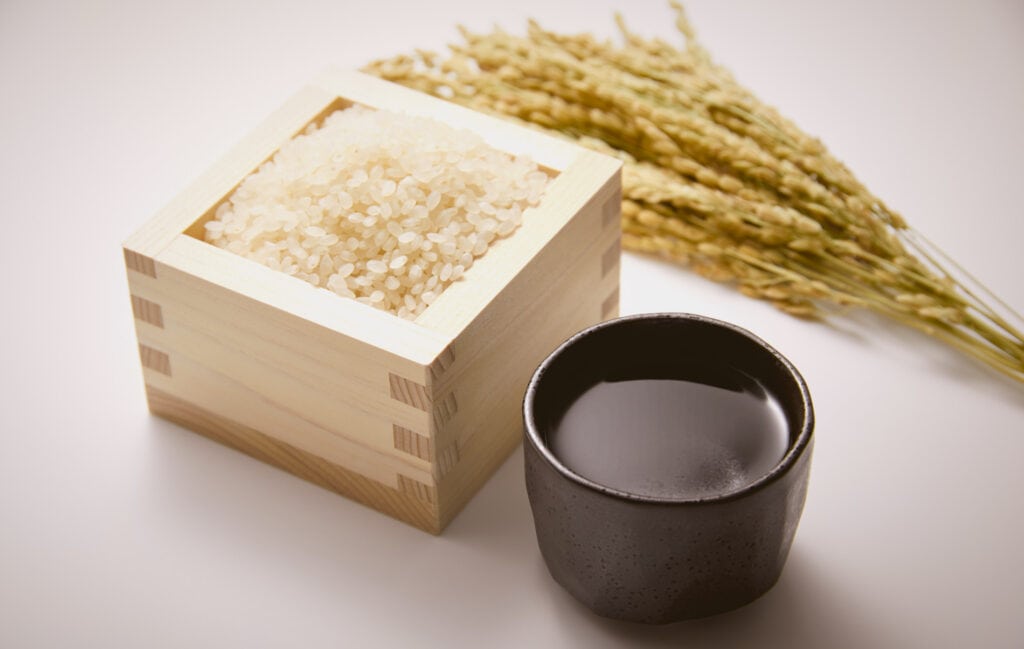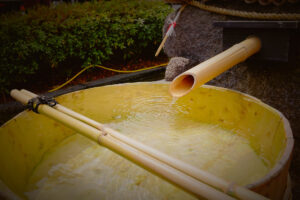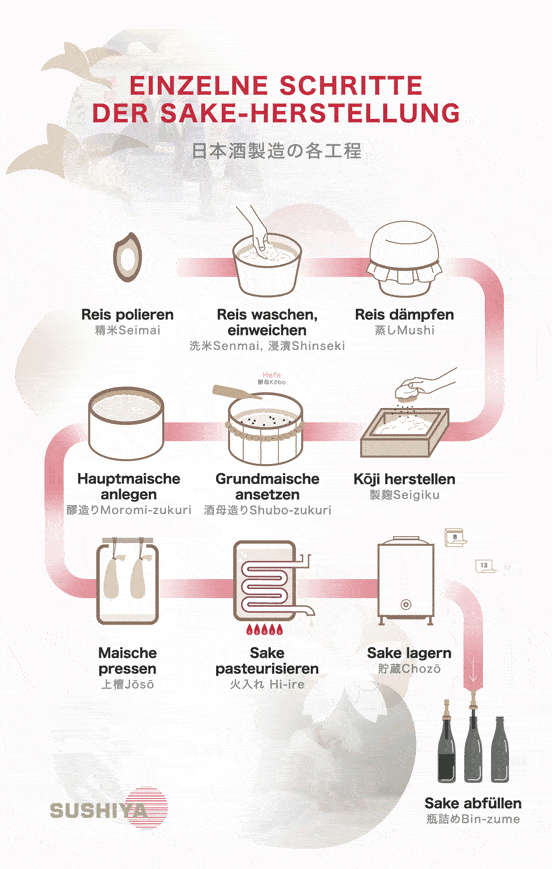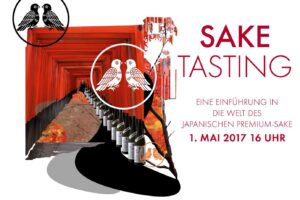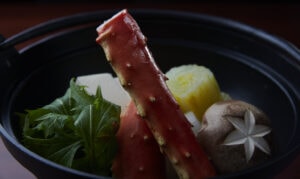Hardly any alcoholic brewing process is as elaborate and complex as sake production.
Brewing the Japanese national drink has a centuries-old tradition and reflects the high art of Japanese craftsmanship. Sake is even considered the "drink of the gods" in Japan and is also often served in important religious ceremonies.
Is sake wine?
It is true that good sake and good wine can be compared in terms of cultural significance, alcohol content and aromatic richness within Japanese and European cultures.
However, the production process is different: when pressing the wine, the juice comes from the grapes - in sake, the liquid is added to the rice in the form of water. The quality and nature of the water is therefore of considerable importance.
In wine, grapes contain sugar, so when yeast is added to the pressed grapes, alcoholic fermentation takes place.
On the other hand, rice and wheat contain a lot of starch but no sugars, so the starch must first be converted into sugar for a brewing process to begin.
The brewing process of Japanese sake is therefore more reminiscent of the production of beer than wine.
The special feature of sake production is therefore a twofold fermentation process that takes place in parallel. Starch is converted into sugar, while yeast bacteria convert this in turn into alcohol.
What ingredients are used to make sake?
In Japan, sake has been considered the "drink of the gods" since time immemorial in Shintoism, the original Japanese religion, so to speak, in which purity plays a major role. Due to the brewing process, sake is therefore considered very pure and therefore only very few ingredients are used for brewing sake - actually there are only two visible and tangible ingredients and then one invisible...
Basis for good sake: (Japanese) water
Most sake breweries are therefore located near natural water sources. The soft spring water is particularly suitable for sake production. It is used at every step of the brewing process: first for washing the rice, then for steaming, and finally to regulate the alcohol content.
A closer look at the different types of sake and different regions and breweries in Japan is therefore also a journey through the island kingdom and its water sources. Small outlook: Japanese water is considerably softer than what we know in Europe...
Special rice for sake making
Access to good water is very important to the location of sake breweries. Water is not only used in all stages of sake brewing, but also makes up a large part of the finished sake. Therefore, the taste of the type of rice used is ultimately less important than the taste of the grape in wine.
Nevertheless, of course, you need rice with very special properties to brew a good sake from it.
The mysterious ingredients for sake: Kōji and yeast
Just as important as choosing the right kind of rice and a good spring water is the production of the special Kōji (cultivated noble mold) for a good sake.
This noble mold culture (Japanese: "Kōji") grown from fermented rice provides the enzymes and thus ultimately the fermentation process of the brewing process.
The Kōji mushroom is a basic ingredient in many areas of Japanese cuisine. It plays an indispensable role in the production of quite a few foods of the island country, is used among other things for Soy sauces and for Miso Pastes used.
Making food preservable and also beneficial to health by fermenting it has a centuries-old tradition in Japan. There are different Kōji cultures for this purpose, which are named after their color. The yellow Kōji mushroom is usually used for sake.
The production of Kōji and its use in the brewing process require intuition and many years of experience to ensure that the two-stage fermentation process proceeds perfectly and the desired aroma can develop. The water-soluble starch must first be converted into soluble sugar. In a second step, this is then fermented into alcohol by yeast (Kōbo).
From wild yeasts to exclusive breeds for sake production
In the past, sake brewers relied on the "wild yeasts" naturally occurring in the area.
At the end of the 19th century, people began to selectively collect particularly suitable yeast cultures. Since 1906, the Nihon-Jozo-Kyokai (日本醸造協会, Japanese sake brewers' association) has been cultivating strain yeasts that can be purchased by breweries. These yeasts were and are simply numbered in order of discovery.
The taste of the sake and its very special aroma is decisively influenced by the parent yeasts. Connoisseurs can taste the yeasts used. Some breweries use exclusive breeds of their own and also note these on the back label of the bottles.
How is sake brewed?
Sake is exceptional in two areas of alcoholic beverage production: parallel fermentation and alcohol content.
First, the two necessary fermentation processes in sake brewing take place in one tank without interruption in time (parallel fermentation):
The Kōji fungus converts the starch into sugar - and at the same time yeast bacteria convert sugar into alcohol (plus carbon dioxide). This distinguishes the sake brewing process from that of beer. When brewing beer, the conversion of starch to sugar according to the Mashing fully completed before fermentation begins.
Secondly, there is no other fermented beverage in the world that has such a high alcohol content (20%) after production as sake.
Production of sake is laborious manual work
Sake brewing is a very complex and lengthy process.
The living components Kōji and Kōbo need experience and attention.
A little too much or not enough heat, a little too long hesitated or not quickly enough cooled again - already the desired result can not occur. That's why, by the way, people traditionally like to brew in winter to take advantage of the natural cold of the season.
The brewmaster is referred to as "Tōji" and, similar to other experienced craftsmen, is held in high esteem in Japan. With his knowledge and trained taste, he influences and alters the fermentation process to produce a unique final product.
Like a good sushi chef, a good Tōji refines his art over many years. Europeans and Americans rarely muster this kind of stamina. Therefore, there are hardly any sake productions outside of Japan, even though sake is also very popular here.
However, recently there have been isolated ambitious attempts in Europe and America to brew good sake outside Japan.
You can find out exactly how the brewing process works in a detailed description of the individual steps of sake production.
